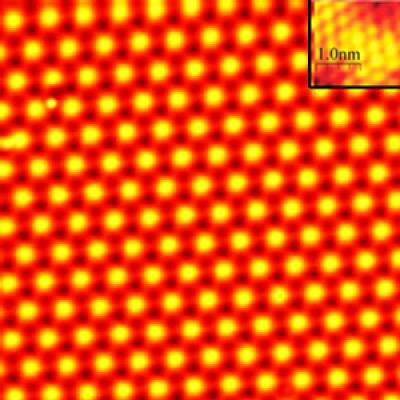Home > Press > Researchers create a superconducting sheet of lead only two atoms thick
 |
| This is a scanning tunneling microscope image of the 2-atom thick lead film. The inset is a zoomed view showing the atomic structure. (Image: Dr. Ken Shih, The University of Texas at Austin) |
Abstract:
A superconducting sheet of lead only two atoms thick, the thinnest superconducting metal layer ever created, has been developed by physicists at The University of Texas at Austin.
Researchers create a superconducting sheet of lead only two atoms thick
Austin, TX | Posted on June 8th, 2009Dr. Ken Shih and colleagues report the properties of their superconducting film in the June 5 issue of Science.
Superconductors are unique because they can maintain an electrical current indefinitely with no power source. They are used in MRI machines, particle accelerators, quantum interference devices and other applications.
The development of the thin superconducting sheets of lead lays the groundwork for future advancements in superconductor technologies.
"To be able to control this material—to shape it into new geometries—and explore what happens is very exciting," says Shih, the Jane and Roland Blumberg Professor in Physics. "My hope is that this superconductive surface will enable one to build devices and study new properties of superconductivity."
In superconductors, electrons move through the material together in pairs, called Cooper pairs.
One of the innovative properties of Shih's ultra-thin lead is that it confines the electrons to move in two dimensions, or one "quantum channel," like ballroom dancers gliding across the floor. Uniquely, the lead remains a good superconductor despite the constrained movement of the electrons through the metal.
About CEA/Leti
Shih and his colleagues used advanced materials synthesis techniques to lay the two-atom thick sheet of lead atop a thin silicon surface. The lead sheets are highly uniform with no impurities.
"We can make this film, and it has perfect crystalline structure—more perfect than most thin films made of other materials," Shih says
####
About University of Texas at Austin
The University of Texas at Austin is dedicated to improving the quality of life of the people of Texas and the United States. We are a leading provider of education and research with a depth and diversity of resources unmatched by most other public universities. As an enduring symbol of the spirit of Texas—big, ambitious and bold—the university drives economic and social progress in Texas and serves our nation as a leading center of knowledge and creativity.
For more information, please click here
Contacts:
Office of Public Affairs
512-471-3151
Copyright © University of Texas at Austin
If you have a comment, please Contact us.Issuers of news releases, not 7th Wave, Inc. or Nanotechnology Now, are solely responsible for the accuracy of the content.
| Related News Press |
News and information
![]() Researchers develop molecular qubits that communicate at telecom frequencies October 3rd, 2025
Researchers develop molecular qubits that communicate at telecom frequencies October 3rd, 2025
![]() Next-generation quantum communication October 3rd, 2025
Next-generation quantum communication October 3rd, 2025
![]() "Nanoreactor" cage uses visible light for catalytic and ultra-selective cross-cycloadditions October 3rd, 2025
"Nanoreactor" cage uses visible light for catalytic and ultra-selective cross-cycloadditions October 3rd, 2025
Possible Futures
![]() Spinel-type sulfide semiconductors to operate the next-generation LEDs and solar cells For solar-cell absorbers and green-LED source October 3rd, 2025
Spinel-type sulfide semiconductors to operate the next-generation LEDs and solar cells For solar-cell absorbers and green-LED source October 3rd, 2025
Announcements
![]() Rice membrane extracts lithium from brines with greater speed, less waste October 3rd, 2025
Rice membrane extracts lithium from brines with greater speed, less waste October 3rd, 2025
![]() Researchers develop molecular qubits that communicate at telecom frequencies October 3rd, 2025
Researchers develop molecular qubits that communicate at telecom frequencies October 3rd, 2025
![]() Next-generation quantum communication October 3rd, 2025
Next-generation quantum communication October 3rd, 2025
![]() "Nanoreactor" cage uses visible light for catalytic and ultra-selective cross-cycloadditions October 3rd, 2025
"Nanoreactor" cage uses visible light for catalytic and ultra-selective cross-cycloadditions October 3rd, 2025
|
|
||
|
|
||
| The latest news from around the world, FREE | ||
|
|
||
|
|
||
| Premium Products | ||
|
|
||
|
Only the news you want to read!
Learn More |
||
|
|
||
|
Full-service, expert consulting
Learn More |
||
|
|
||








